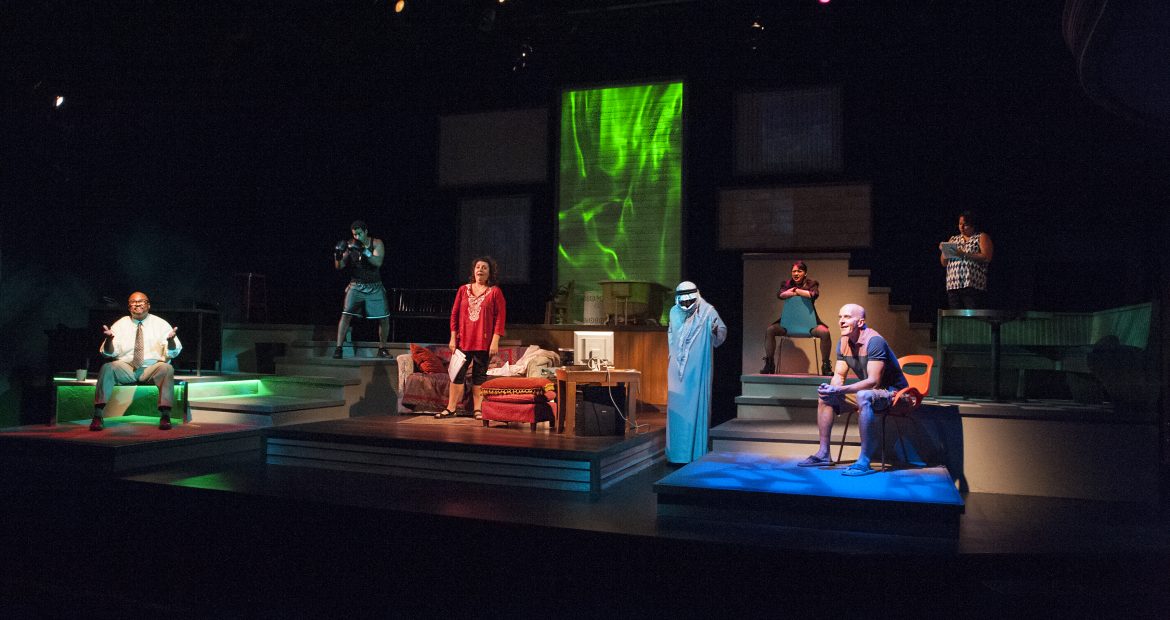 A designer’s job is to enhance and help the audience visually follow both the story and character relationships on stage. Water by the Spoonful shows just how chaotic human relationships can be in our modern world. A chat room connects four of the main characters: while they are together online talking in real-time to each other, each is on opposite ends of the globe in their own home. The scenes shift between that virtual chat room to real-life locations like a diner and college classroom, then the scenes delve into the depths of one character’s mind. While the rapid-fire shift in scene locations might be easy to accomplish in film, in live theatre, it’s a real design challenge.
A designer’s job is to enhance and help the audience visually follow both the story and character relationships on stage. Water by the Spoonful shows just how chaotic human relationships can be in our modern world. A chat room connects four of the main characters: while they are together online talking in real-time to each other, each is on opposite ends of the globe in their own home. The scenes shift between that virtual chat room to real-life locations like a diner and college classroom, then the scenes delve into the depths of one character’s mind. While the rapid-fire shift in scene locations might be easy to accomplish in film, in live theatre, it’s a real design challenge.
At Curious, our lighting and projection designers were key in creating a world where all those things can happen and the audience is clear where the action is taking place. “With numerous locations and three story lines to keep straight, the audience must be able to identify quickly at the beginning of each scene exactly where we are,” said lighting designer Dick Devin.
Brian Freeland, projection designer for the show echoes that thought. “We had to link Tokyo, Puerto Rico, Philadelphia and create a visual representation of a chat room, without putting the characters or text on screens.”
The lighting and projection designs focus primarily on clarifying whether we are seeing the characters in a face-to-face interaction or not, supporting the scenic design of Markas Henry (check out the story on his design in the playbill for this show). The face-to-face scenes are established with the naturalistic light of a recognizable place, such as the diner, an apartment, and a flower shop.
The chat room scenes distinctly isolate individual characters in a more presentational tight space. The digital “place” for these scenes is established with a colorful light pointed down onto the floor; additionally, LED lights were used around the platforms the characters stand on, giving each one a glow reminiscent of technology. As you watch the play, notice that as a chat room character changes location on stage from platform to platform, the color of the glow around that character’s area remains the same; for example, the character Orangutan is bathed in orange light no matter where she appears on stage. The chat room is further emphasized through projection of each character’s screen avatar behind them when they are online.
The third reoccurring reality, that of the ghost in Elliot’s mind, is accompanied by a “night vision glow” – the same green glow that followed Elliot’s memory of battle in the first play, Elliot: A Soldier’s Fugue that was created by Dick to mimic night vision goggles worn in combat. As the ghost returns in Water By the Spoonful, the green glow and accompanying glow around platforms increases in intensity, as the psychological weight of the nightmare increases in intensity for Elliot.
In addition, Brian uses projections in the transitions between scenes with images of water to tint the emotional content of the scenes. Brian explains, “I wanted to emphasize the fluidity of water, that it can take on different colors and emotions and make each scene feel different.”
With just three weeks remaining until the Water runs out, we invite you to see this show and let us know how you react to the lights and projections that color this world on stage.
